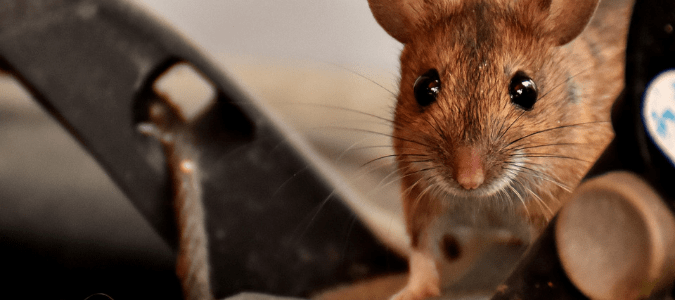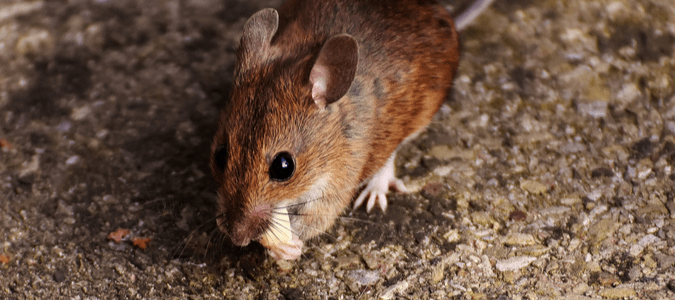Scurrying, squeaking or scratching noises in the walls at night typically means one thing; rodents. The 2021 American Housing Survey, conducted by the U.S Census Bureau, reveals that almost 15 million homes in the U.S. reported rodent sightings last year.
Mice and other rodents aren’t just a danger to your walls, wiring and insulation either.
The saliva, urine and feces of mice or rats can spread a host of deadly diseases to humans and pets.
Common Signs of Mice in Walls
Mice can be noticeable house guests, leaving droppings and gnaw marks behind as they search for food and shelter.
These signs can not only indicate their presence in your home but help narrow down the specific areas they’re regularly invading. If you find shredded packaging, food remains or droppings in your pantry, it’s a sure sign that mice are helping themselves to your food.
Scattered bits of insulation, cardboard or plastic wiring are a good bet that they’re making nests in your attic or basement.
Mice themselves have a musky scent that can indicate their presence as well.
In the more frequented areas of the house, you’re likely to find these signs first thing in the morning, as mice tend to be most active at night.
How Do Mice Get In?
However, before mice start nibbling on your dry goods or shredding your keepsakes, they must find a way into the house.
A young mouse can squeeze through gaps or under a doorway that offers as little as quarter of an inch of clearance. Cracked foundations, poorly fitting door or window frames or holes in screens or siding can all make for easy entrance points.
Like all rodents, mice prefer dark, out-of-the-way areas where they feel protected and safe. The interior of your walls offers the perfect personal highway to any area of the house that offers food or water.
Often the only giveaways that these mice are in your walls are the gnawing or scuttling sounds they make while helping themselves to nesting materials and moving from place to place.
If you have dogs or cats, they will often paw or dig at areas where they can hear or smell these disease-carrying rodents that are invisible to us.
A trained pest control professional can inspect your walls and identify any infestation, as well as make recommendations for eliminating these pests.
Because mice are so small, they can easily access homes and other buildings. Infestations by mice are up to 20 times more likely than those of rats.
Preventing Mice in Your Home
The first key to preventing these pests in your walls or home is knowing how mice get in the house and denying them access in the first place. Any holes or gaps larger than the thickness of a pencil must be tightly sealed using steel wool or silicon-based caulking.
Other tips include:
- Cover all vents and external openings (like chimneys) with fine mesh
- Repair and fill cracks and holes on the exterior of the home
- Install sweeps on all exterior doors
- Replace or repair any damaged window screens
- Replace damaged weather stripping, molding, or missing mortar
- Keep firewood and other material stacks at least 20 feet away from exterior walls or foundations
- Inspect all packaging or furniture for signs of damage or infestation before bringing it into the home
The second key to keeping mice away is sanitation.
Most pests enter our homes looking for a combination of three things: food, water and protection. Controlling all these elements can be difficult. A rigorous and thorough cleaning regimen can help reduce the risk of infestation, poor sanitation will certainly encourage it.
Remove dry foods from cardboard and store them in “gnaw-proof” packaging. Clean and sanitize prep areas after every use. Store both trash and pet food in rodent-proof containers. Finally, don’t leave pet food or water in bowls after your pets have eaten, it’s like offering a free buffet to rodents.
Where to Put Mice Traps
Besides calling a pest control professional, as a homeowner, you really only have three options available to you to get rid of mice in your home. These are:
- Toxic baits
- Mechanical traps
- Glue board traps
Mechanical traps are often a homeowner’s best bet, as long as they are used in sufficient numbers and accurately placed. Traps have several advantages over other methods of pest control:
- Traps don’t rely on potentially dangerous poisons or rodenticides and are safer around pets and children.
- Traps allow the homeowner to immediately see if they’ve been successful or not.
- Traps contain the dead rodent and keep its body in one place. Homeowners can empty them immediately. This reduces odors and the likelihood of attracting other pests.
- You can reuse traps over and over, with just a little additional bait.
- Mechanical traps are relatively inexpensive, easy to use and widely available.
- You can use a variety of common household ingredients like peanut butter, grains, raisins, or bacon in traps.
Mechanical snap traps with an expanded trigger are more effective in trapping mice than the older designs.
Mouse Trap Strategy
Experts agree once mice have established a location that provides food, water and shelter, they will only forage minimal distances from their nesting area. This means that the homeowner’s greatest chance for success comes from placing the traps within these areas. These are typically where signs of mouse activity are most apparent and consistent.
Be sure to read all of the instructions that come with each trap closely. While not likely to cause serious injury, having a mouse trap snap closed on your finger isn’t a pleasant experience either.
Bait the trap, set the trigger and carefully place it. Mice tend to travel along the edges of a room for safety, so place traps with the baited end against the wall so that the mouse has to either cross the trigger or go around the entire trap.
Be sure to put some mouse traps in out-of-the-way areas, as well, like behind kitchen appliances or in the backs of cabinets. These are areas where mice feel safe and may be less suspicious.
Another good area for mouse trap placement are any spots where you suspect that the pests might be entering your home, like attics and crawlspace. Set some traps in sheds and other outbuildings as well. Stopping pests before they get a chance to enter your home is a double win.
Bait Your Traps
When setting a trap, you’ll want to know what to put in a mouse trap. Place a small dab of bait, like chunky peanut butter, on the bait pan of the snap trap. You want something that will hold in place, forcing the mouse to apply enough pressure to spring the trap.
Check Your Traps
Check your traps daily and if any haven’t produced any results after a few days, try moving them to a different spot.
Traps that do catch mice should be re-baited and set back in the same location. Reset these traps until they stop producing mice. Dispose of dead mice in sealed plastic bags. Wear gloves when handling dead mice or used traps to protect from disease.
When Do Mice Have Babies?
The common house mouse is a small rodent, with adults reaching lengths of five to seven inches. They typically have large, upward-pointing ears, and small black eyes. The average mouse is tan to gray in color and weighs around a half-ounce.
Often, mice will seek shelter in the home at the onset of fall, as outdoor temperatures begin to drop. Mice have a lifespan of one and a half to two years, based on their living conditions, and can reproduce at an astounding rate.
Mice Life Cycle
In just one year, a single female can have up to 10 litters, with as many as 6 young per litter.
Infant mice are born blind and without ears or fur. To survive, they are protected, kept warm and nursed for around 21 days. Their ears develop by day four, fur grows in by day ten and they can open their eyes at two weeks. Following the three-week nursing period, mice leave the nest.
Females will be fully mature and able to reproduce by two months old. The original mother can have had up to two more litters by then. It’s easy to wonder if you see one mouse, how many do you have?
With a two-year lifespan and this exponential reproduction rate, it’s not hard to see how quickly a mouse infestation can take over a home or property.
While proper trap placement and baiting can be extremely effective for the DIY homeowner, it can take a lot of traps to make a dent in an infestation. This kind of effort in eliminating mice in your home is best left to professional exterminators. Pest control professionals have the training, expertise and advanced equipment to deal with an established population of mice.
They can do so much more quickly and effectively than the average homeowner. Pest control pros are often the safest and most cost-effective route to a mouse-free house in the long run.
ABC Can Treat and Prevent Mouse Problems
Mice are pesky little creatures that can make life difficult for homeowners. Instead of trying every trick in the book, contact ABC Home & Commercial Services. We will create a thorough rodent control plan tailored to your home. You and your family will feel at ease again with our professional services.


